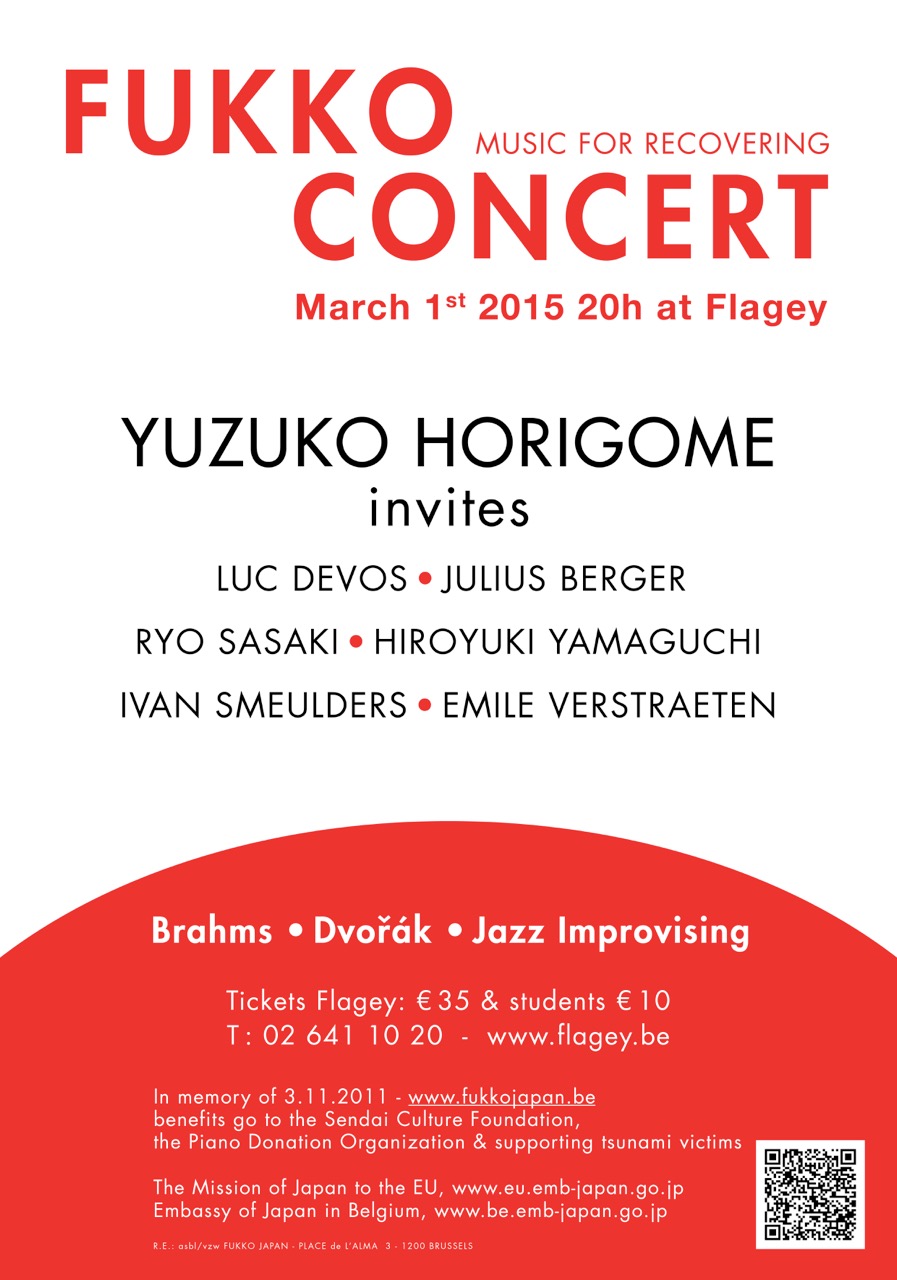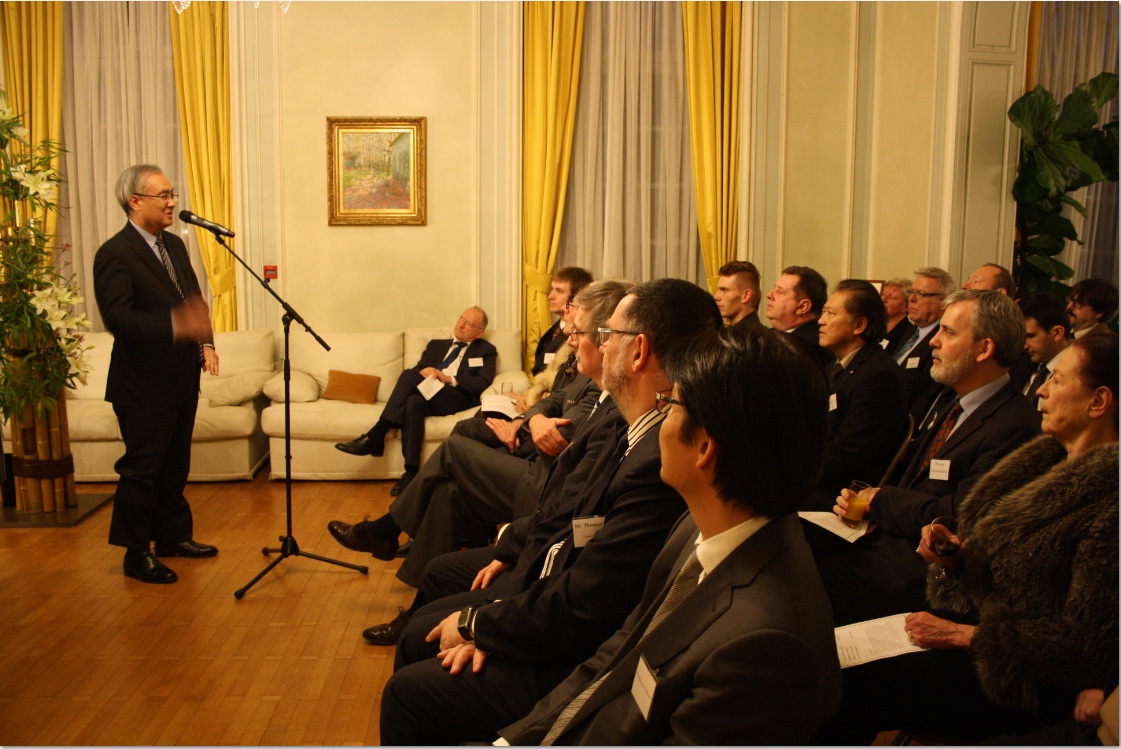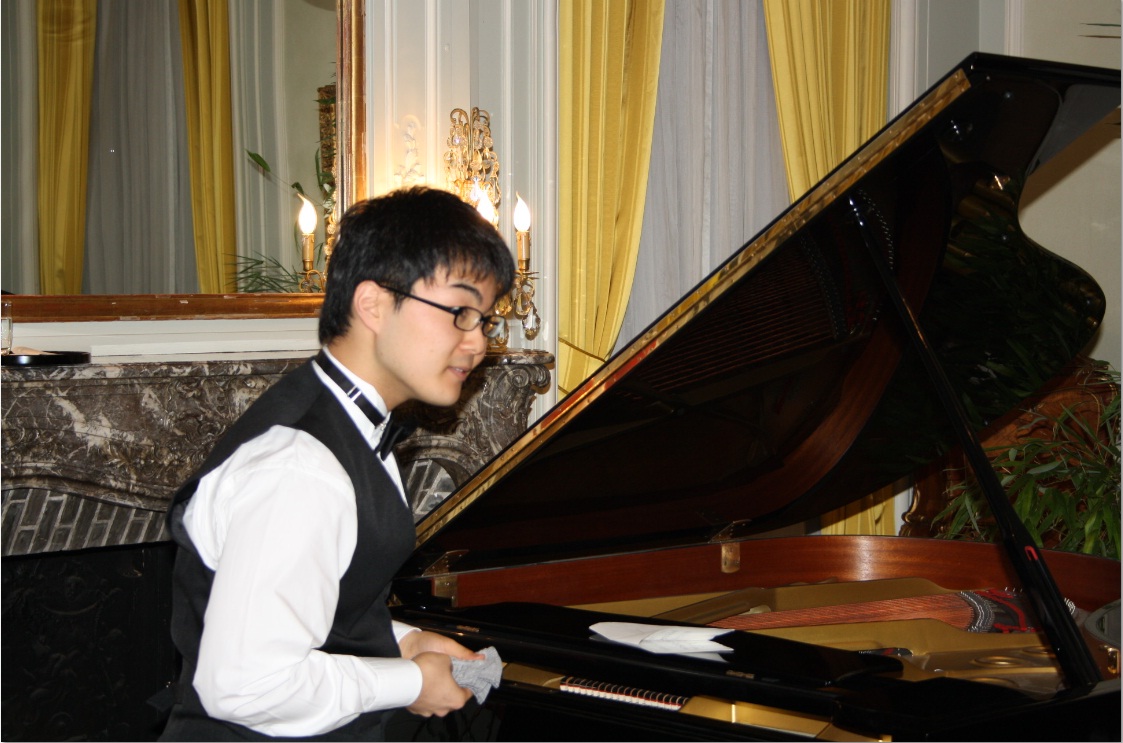
Thinking About the Great Earthquake Disaster at its 4th Anniversary (No.12)
23rd of March 2015
Last March 11 marked the 4th anniversary of the Great East Japan Earthquake. Prior to it, a Charity Concert which I also attended was organized here in Belgium, as it has been since the occurrence of the great earthquake. In addition, at my Residence, once again we gave our thoughts to the Great Earthquake in the company of Belgians that supported Japan in various ways at the time of the disaster, as well as with the “Friends of Japan”, a group of Belgians who have lived in Japan before as a student or business. These occasions reminded me once again of the strength of the relationship between Japan and Belgium.
 At the time of the disaster, I was in my office at the Japanese Ministry of Foreign Affairs, meeting with a foreign guest. Until this day I still remember the two of us being caught by surprise by the big tremor, both getting up in a hurry and promptly supporting a bookshelf to keep it from falling down. When I turned on the TV, there were images of the tsunami. At the same time, the telephone on my desk kept ringing and what followed were restless days. The death toll reached around 16.000 (15.891(*1)), but still more than 2.500 (2.584 (*)) people are missing; it has been the biggest post-war natural disaster in Japan. At the time of the disaster, I was in my office at the Japanese Ministry of Foreign Affairs, meeting with a foreign guest. Until this day I still remember the two of us being caught by surprise by the big tremor, both getting up in a hurry and promptly supporting a bookshelf to keep it from falling down. When I turned on the TV, there were images of the tsunami. At the same time, the telephone on my desk kept ringing and what followed were restless days. The death toll reached around 16.000 (15.891(*1)), but still more than 2.500 (2.584 (*)) people are missing; it has been the biggest post-war natural disaster in Japan.
My honest impression is that four years is long and short at the same time. The initial number of 470,000 evacuees at the time of the Great Earthquake Disaster has been brought down to less than half of that number in December of last year. To put it the other way round, approximately 230,000 people are still forced to live away from their home, among which more than 80,000 continue to stay in temporary housing units. (*2)
The Industrial Production Index of three of Tohoku’s prefectures (Iwate, Miyagi and Fukushima) has roughly been restored to pre-Great Earthquake level. On the other hand, as for the companies receiving subsidies in relation to the Great Earthquake, when looking at the sales by industry, 72% of the construction industry has been restored to its initial level, but the ratio in the fisheries and food industry is stuck at 19% (*2).
 Concerning nuclear power generation, except for the soon to be decommissioned Fukushima Daiichi reactor, there are 48 nuclear power plants in Japan and all of them remain shut down. On the other hand, having experienced the accident, Japan thereafter developed new safety standards to guarantee the highest level of security. Several power plants have already passed the inspection based on those standards. I believe there is much debate, but when thinking about future energy demand, about how to deal with global warming and furthermore considering the fact that Japan’s neighboring countries are planning to build many nuclear power plants, I think that one of the important choices for Japan is to become a center of knowledge and technology that takes the international lead in ensuring the safety of nuclear reactors, by making the best use of Japan’s experience with the accident. Concerning nuclear power generation, except for the soon to be decommissioned Fukushima Daiichi reactor, there are 48 nuclear power plants in Japan and all of them remain shut down. On the other hand, having experienced the accident, Japan thereafter developed new safety standards to guarantee the highest level of security. Several power plants have already passed the inspection based on those standards. I believe there is much debate, but when thinking about future energy demand, about how to deal with global warming and furthermore considering the fact that Japan’s neighboring countries are planning to build many nuclear power plants, I think that one of the important choices for Japan is to become a center of knowledge and technology that takes the international lead in ensuring the safety of nuclear reactors, by making the best use of Japan’s experience with the accident.
 Finally, especially with the Belgian people in mind, I would like to share a nice story broadcasted by NHK. It is the story about a mother and a boy on the day of the Great Earthquake disaster. Their house had been washed away, they had lost their family and they stayed together with many disaster victims in an evacuation center. The mother, stricken with sadness and despair, looked down, sobbing. Then, the boy’s voice was heard from outside; “mother, come outside. Hurry, hurry”. Thinking that something had happened, the mother promptly went outside and what she saw was the boy, with a smile on his face, looking upwards, pointing at the sky. “Mother, the sky is full of stars. It’s the first time for me to see this many beautiful stars”. At the day of the Great Earthquake, there was of course a power outage throughout the entire region. In the darkness, apart from other things that had not been visible until then, a lot of stars were shining. In the NHK program, four years after the disaster, there was a scene with the same mother and son at a planetarium showing what the sky looked like on that day. “When looking at the smiling face of my child that day, I could not simply look down and be sad. I thought I have to look up, look forward and live” the mother pointed out. From now on, I would like to keep this story close to my heart. Finally, especially with the Belgian people in mind, I would like to share a nice story broadcasted by NHK. It is the story about a mother and a boy on the day of the Great Earthquake disaster. Their house had been washed away, they had lost their family and they stayed together with many disaster victims in an evacuation center. The mother, stricken with sadness and despair, looked down, sobbing. Then, the boy’s voice was heard from outside; “mother, come outside. Hurry, hurry”. Thinking that something had happened, the mother promptly went outside and what she saw was the boy, with a smile on his face, looking upwards, pointing at the sky. “Mother, the sky is full of stars. It’s the first time for me to see this many beautiful stars”. At the day of the Great Earthquake, there was of course a power outage throughout the entire region. In the darkness, apart from other things that had not been visible until then, a lot of stars were shining. In the NHK program, four years after the disaster, there was a scene with the same mother and son at a planetarium showing what the sky looked like on that day. “When looking at the smiling face of my child that day, I could not simply look down and be sad. I thought I have to look up, look forward and live” the mother pointed out. From now on, I would like to keep this story close to my heart.
By the way, going back to the reception which I mentioned in the beginning, Kaito Kobayashi, a young pianist who is currently studying in Belgium, was kind enough to hold a mini concert at the residence. I think that those present were deeply impressed by his musical performance, both delicate and dynamic. Mr. Kobayashi is a young prodigy, turning 20 this year.
Next year will be, along with the 5th anniversary of the Great Earthquake Disaster, the 150th anniversary year of the establishment of diplomatic relations between Japan and Belgium. On that occasion, I would like to endeavor to have the Japanese-Belgian relations, which became even closer in the wake of the Great Earthquake, to be continued to the next generation and the ones after that.
*1; Police Department Statement on March 10, 2015
*2; Reconstruction Agency Data, March 4, 2015
|

